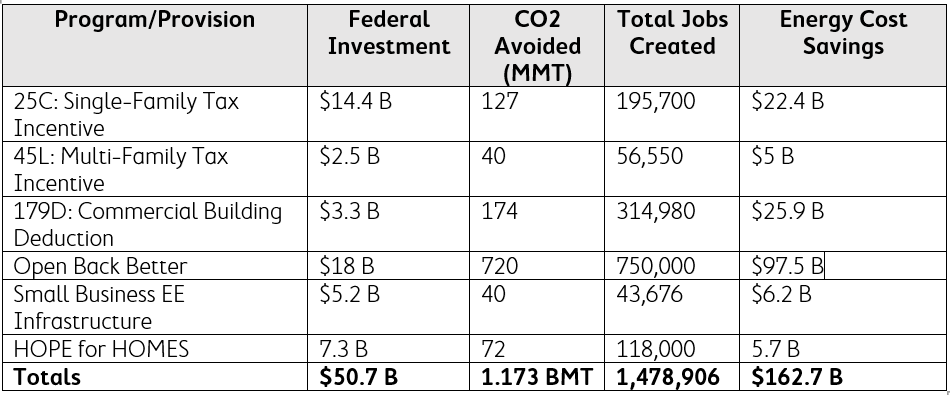“Infrastructure Week” may have turned into infrastructure year, but as August recess approaches, Congress is closer than ever to passing historic legislation that would transform America’s energy system.
Unsurprisingly, one major remaining sticking point is the price tag— and while the short-term view might be to put some programs on the chopping block in order to bring costs down, the long-term wisdom holds that certain initiatives actually save taxpayers money over the long run through their inclusion. Nowhere is this more ubiquitous than in energy efficiency programs, which almost universally save more taxpayer money than they spend by reducing energy costs. Here are a few energy efficiency policies which, if included in an infrastructure package, would result in nearly 1.5 million jobs and more than $100 billion of net savings.
THE POLICIES
- Open Back Better Act. This legislation led by Rep. Lisa Blunt Rochester (D-Del.) and Sen. Tina Smith (D-Minn.) invests in critical public buildings like hospitals, universities, schools, and airports to improve building energy efficiency and safety. The legislation also targets these investments to disadvantaged communities, ensuring that jobs, energy cost savings, and environmental benefits reach where they are needed most.
- Main Street Efficiency Act. With small businesses still under duress from COVID-19, this soon-to-be introduced bill from Rep. Peter Welch (D-Vt.) and Sen. Catherine Cortez Masto (D-Nev.) would provide low- to no-cost efficiency upgrades to small businesses through a Department of Energy grant program, offering them permanent utility bill savings.
- Tax Incentives. The 25C tax credit for homeowner energy efficiency, the 179D deduction for commercial buildings, and the 45L credit for new construction are intended to increase the upfront value of efficiency – but many of these incentives are woefully out-of-date and too weak to stimulate significant demand – and all of them should be strengthened to match the current climate challenge. Modernizing these incentives to ensure energy efficiency penetration throughout the built environment, including in existing and new single-family homes, multi-family structures, and commerical buildings is a step in the right direction and will result in significant carbon reductions. The Alliance led a letter to Congress this week signed by more than 1,000 organizations calling for reforms to the homeowner credit.
- ENERGY STAR. ENERGY STAR is a success story on all fronts – in 2019 alone, it saved consumers more than $39 billion on energy costs and avoided 390 million metric tons of greenhouse gas emissions. Moreover, according to the most recent U.S. Energy Employment Report, ENERGY STAR appliances was the largest category of employment in the energy efficiency sector, employing 25% of the efficiency workforce in 2020. Unfortunately, despite the program’s significant benefits for carbon reductions and jobs, ENERGY STAR has actually seen its budget decrease in recent years; down to $39 million in 2020. It’s time to double down on what works and increase the ENERGY STAR budget to $80 million.
- Workforce development. The Blue Collar to Green Collar Jobs Development Act, led by Rep. Bobby Rush (D-Ill.), would help provide training for green jobs, with an emphasis on communities that are not currently well-represented in the energy sector. The legislation helps to ensure the efficiency workforce of the future is diverse, well-qualified, and well-paid.
- Broadband. Energy efficiency is becoming increasingly digitalized – which presents new opportunities and challenges for Active Efficiency, including closing the “efficiency gap” which leaves too many of those most in need of energy cost savings without access to Active Efficiency technologies. Infrastructure legislation should invest in Active Efficiency, including by providing universal access to broadband so no one is left behind.
It’s a cliché in Washington to say that a program “pays for itself,” but in the case of energy efficiency, that’s simply true. Legislative proposals such as Open Back Better, energy efficiency tax modernization, and others substantively forward national climate policy, economic growth, and put money back into the pockets of the households and communities who most need it.

Chart compiled from data from the American Council for an Energy-Efficiency Economy’s 2021 factsheet on clean infrastructure and 2020 analysis of COVID-19 stimulus solutions.
Energy efficiency must be the foundation of energy and infrastructure policy. Prioritizing energy efficiency legislation is common sense for our planet, for our communities, for our economy, and for our nation’s wallet.